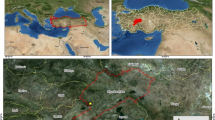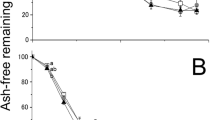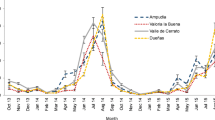Abstract
It is important to study the effect of tree density on the substrate quality and decomposition rate of leaf litter in plantations. In 2002, an experiment of the effects of thinning intensities at four different levels (i.e., 0 (I), 35.7% (II), 49.2% (III), and 64.2% (IV)) on undergrowth were carried out in an 18-year-old Pinus tabulaeformis plantation at an initial density of 3130 trees/hm2 in the middle of the hills of Yingpan, Yanqing County, Bei**g. Three years later, the rates of decomposition, the amount of nutrients returned, and the characteristics of leaf litter were compared by a litter bag method. The results show that the annual loss of dry matter of leaf litter in plots I, II, III, and IV was 25.81%, 26.25%, 27.68%, and 25.96%, respectively. The turnover of leaf litter was 10.04, 9.84, 9.24, and 9.97 years, respectively. Therefore, it is feasible and convenient to evaluate the effect of thinning on the rate of decomposition. In the first two months, the N, P, K, and Mg nutrients were released quickly. During the entire observation period of 14 months, the return of both N and Mg nutrients in the four plots exhibited a release-accumulation type of cycle. The return of P and K indicated a trend of release-accumulation and a relative balance. However, the return of Ca was far different from that of the other nutrients in the four plots. The total nutrient return of the four elements N, P, K, and Mg in the plots was 10.806, 31.016, 31.798, and 39.365 g/kg, respectively. Specifically, the quality of leaf litter in plot I was the worst in that N and Ca accumulated only 2.567 and 0.767 g/kg, respectively. Thinning did decrease the ratios of lignin to N and C to N and accelerated the rate of decomposition of leaf litter. The content of crude ash in leaf litter was enhanced by thinning, which prevented acid material, such as tannins and resins, from returning to the soil. The effect of thinning intensity was evaluated by the ratio of lignin to N, the ratio of C to N, and the ash content in leaf litter.
Similar content being viewed by others
References
Aerts R (1997). Climate, leaf chemistry and leaf litter decomposition in terrestrial ecosystems: a triangular relationship. Oikos, 79:439–449
Bao S D (2000). Soil and Agricultural Chemistry Analysis. Bei**g: China Agricultural Press, 263–274 (in Chinese)
Beare M H, Parmelee R W, Hendrix P F, Cheng W, Coleman D C, Crossley Jr D A (1992). Microbial and faunal interactions and effects on litter nitrogen and on decomposition in agroecosystems. Ecol Monogr, 62:569–591
Dong M, Wang F Y, Kong F Z (1996). Survey, observation and analysis of terrestrial biocommunities. Bei**g: Standards Press of China, 153–159 (in Chinese)
Dong S R, Shen G F, Nie D P (1986). Studies on the nutrient cycling of Pinus tabulaeformis plantations. II: Dynamic properties of the nutrient elements in a Pinus tabulaeformis plantation stand. J Bei**g For Univ, 8(1):11–22 (in Chinese)
Gao J R (1987). Nutrient bio-cycle of Larix principis-rupprechtii plantation in Qingling-gebirges. J Northwest For Univ, 2(1):23–35 (in Chinese)
Hou X Y (1982). Biogeography and the dominant bio-chemical element of China. Bei**g: Science Press (in Chinese)
Jiang Y X, Guo Q S, Ma J (1998). Community characteristics and classification in China. Bei**g: Science Press, Chinese Forestry Press, 3–20 (in Chinese)
Li S L, Chen Y L (2004). Decomposition and nutrient return of the leaf litter under the pure and mixed plantations of Juglans mandshrica and Larix gmelinii. J Northeast Coll For, 28(5):59–62 (in Chinese)
Li Z A, Zou B, Ding Y Z, Cao Y S (2004). Key factors of forest litter decomposition and research progress. Chin J Ecol, 23(6):77–83 (in Chinese)
Liu S R, Li C Y (1993). Nutrient cycling and stability of soil fertility in larch plantation in the eastern part of northern China. J Northeast Coll For, 21(2):19–24 (in Chinese)
Liu Y, Zhang J, Feng MS (2006). Dynamics of litter production, nutrient return and decomposition of four Eucalyptus Grandis plantations. Sci Silv Sin, 42(7):1–9 (in Chinese)
Martius C, Höfer H, Garcia M V B, Römbke J, Hanagarth W (2004). Litter fall, litter stocks and decomposition rates in rainforest and agroforestry sites in central Amazon. Nutr Cycl Agrofor, 68:137–154
Nie D P, Shen G F, Dong S R (1986). Studies on the nutrient elements cycling in the Pinus tabulaeformis plantation. J Bei**g For Univ, 8 (2):8–19 (in Chinese)
Olson J S (1963). Energy storage and the balance of producers and decomposers in ecological systems. Ecology, 44:323–331
Peng S L, Liu Q (2002). The dynamics of forest litter and its responses to global warming. Acta Ecol Sin, 22(9):1534–1544 (in Chinese)
Sariyldiz T, Anderson J M (2003). Interactions between litter quality, decomposition and soil fertility: a laboratory study. Soil Biol Biochem, 35:391–399
Shanks R E, Olson J S (1961). First-year break down of leaf litter in southern Appalachian forests. Science, 134:194–195
Shen H L, Ding B Y, Shen G F, Chen A M (1996). Decomposing dynamics of several coniferous and broadleaved litters in Mongolian scots pine plantation. Sci Silv Sin, 32(5):393–402 (in Chinese)
Swift MJ, Heal OW, Anderson JM (1981). Decomposition in terrestrial ecosystems. Ecology, 69(1):350
Wu J H, Zhang K, Jiang Y (2005). Phytogeography. Bei**g: Higher Education Press, 133 (in Chinese)
Yang Y S, Guo J F, Chen Y X, Chen G S, Zheng Y M (2004). Comparatively study on litter properties between plantations of Fokienia hodginsii and Cunning lanceolata. Sci Silv Sin, 40(3):19–25 (in Chinese)
Zhang D Q, Ye W H, Yu Q F (2000). The litter-fall of representative forests of successional series in Dinghushan. Acta Ecol Sin, 20(6):938–944 (in Chinese)
Zhang X B, Shangguan Z P (2006). Nutrient distributions and bio-cycle patters in both natural and artificial forests in Hilly Loess Regions. Acta Ecol Sin, 26(2):373–382 (in Chinese)
Zhao G F, Cai Y, Luo Y Y, Li M H, Yu M J (2006). Nutrient dynamics in litter decomposition in an evergreen broad-leaved forest in east China. Acta Ecol Sin, 26(10):3286–3295 (in Chinese)
Author information
Authors and Affiliations
Corresponding author
Additional information
__________
Translated from Journal of Bei**g Forestry University, 2008, 30(5): 52–57 [译自: 北京林业大学学报]
About this article
Cite this article
Li, G., Liu, Y., Li, R. et al. Responses of decomposition rate, nutrient return, and composition of leaf litter to thinning intensities in a Pinus tabulaeformis plantation. Front. For. China 4, 458–463 (2009). https://doi.org/10.1007/s11461-009-0058-7
Published:
Issue Date:
DOI: https://doi.org/10.1007/s11461-009-0058-7




